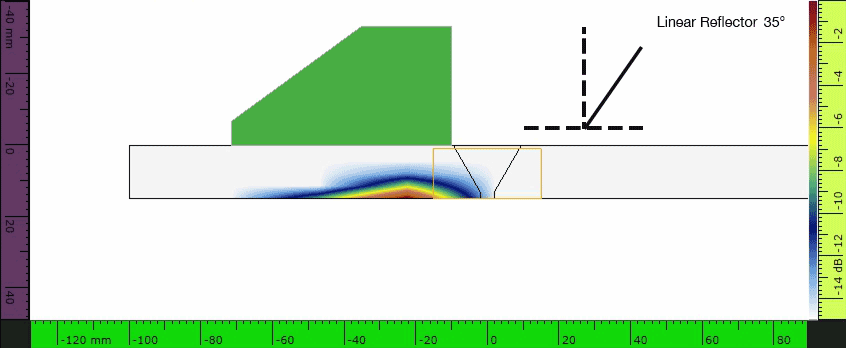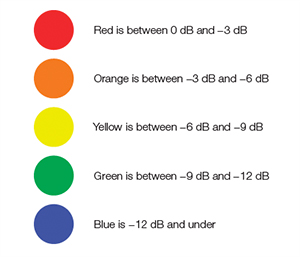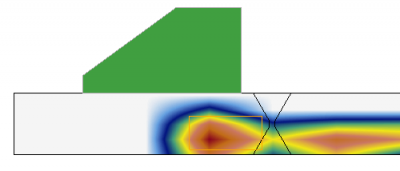Introduction of the Total Focusing Method into NDT
The total focusing method (TFM) has generated a lot of excitement in the nondestructive testing (NDT) field. But there are challenges that had yet to be resolved when using TFM, such as choosing the right mode of propagation (wave set) for a given inspection. Some early adopters of this method quickly realized that using the wrong mode could mean losing an indication from the screen entirely, which came with obvious critical repercussions.
Challenges of Choosing the Proper Settings Using TFM
When selecting a mode of propagation (wave set) for a given inspection, the inspector needs to know what kind of defects may occur in the part to be inspected. The type of defect will give some information on the orientation of the reflector, which is critical when inspecting with ultrasonic testing (UT). With conventional UT, phased array UT, or TFM, the basic principle remains the same. The probability of detection (POD) is highest when the transmitted acoustic beam’s angle of incidence is equal to the angle of reflection on the target reflector. Another consideration is the probe parameters. Depending on the probe used, the acoustic waves may not be capable of reaching the targeted defect with appreciable amplitude. Even though the TFM zone is drawn at a particular location, it is possible that the physics will not allow for this specific probe to focus that far into the part. There are so many factors to keep in mind, so how can we simplify and ensure that our inspection is adequate?
Different Modes | 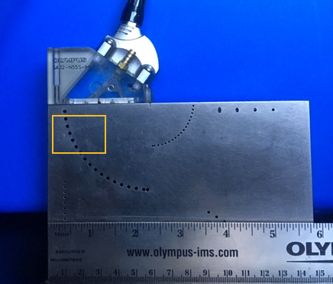 | Same Probe Location |
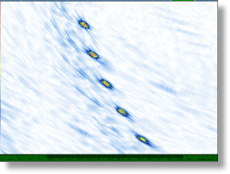 TT |  TTT |  LLL |
Figure 1- Different modes used to try to image a series of SDHs. In this case, the specimen is very thick and the self-tandem modes (TTT and LLL) are poorly adapted.
Solution Using the Acoustic Influence Map Modeling Tool
The OmniScan® X3 phased array flaw detector comes with a built-in scan plan tool. Within it is an Acoustic Influence Map (AIM) modeling tool that was specifically designed for TFM inspection. The AIM tool helps users select the right mode of propagation, or wave set, for their inspection.
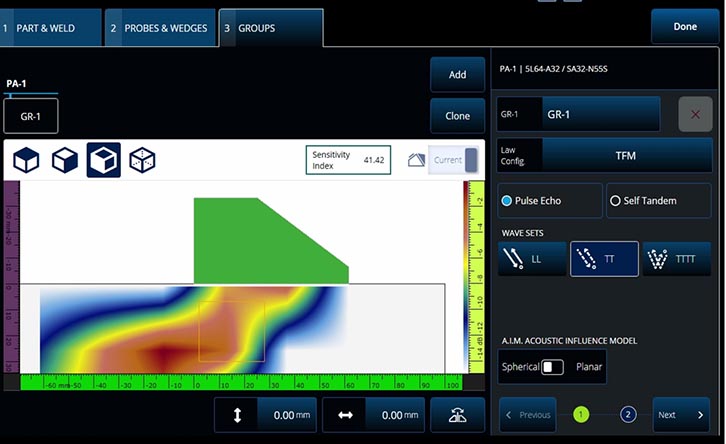
Figure 2- OmniScan X3 scan plan in TFM mode showing the Acoustic Influence Map (AIM) generated for the probe, wedge, and reference standard shown in Figure 1. It predicts the coverage and gives a Sensitivity Index value (41.42) for the TT wave set. The resulting TFM image is also shown in Figure 1 (left). The light orange square in the heatmap above represents the TFM zone (the region of interest that is delimited by the user).
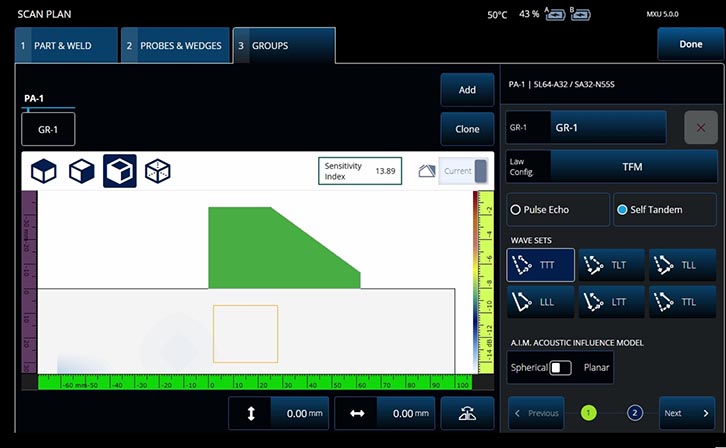 | 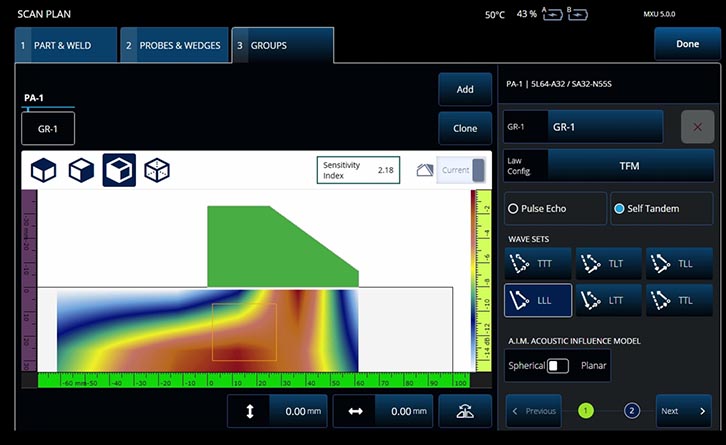 |
Figure 3- The AIM models predicting the coverage and sensitivity for TTT and LLL wave sets in self-tandem mode, with their respective Sensitivity Index (SI) readings, 13.89 for the TTT wave set and 2.18 for the LLL wave set. These correspond to the TFM images shown in Figure 1 (middle and right) for the TTT wave set and the LLL wave set.
The AIM modeling tool considers multiple parameters, including the probe and wedge, velocity, thickness, geometry of the specimen, inspection technique, wave sets, and, of course, the parameters entered by the inspector in the “Influence zone” menu to describe the targeted type of defect.
A flaw’s orientation is the principal factor impacting how well a sound beam will be able to detect it. The AIM model clearly demonstrates for the user how good the signal coverage is at a particular angle for a given flaw. Using the AIM Modeling Tool to Determine the Best Propagation ModeThe user configures the desired zone of interest and then enters the expected orientation (in degrees) of the flaw or selects “omnidirectional” for flaws that are typically smaller than the inspection wavelength, such as porosity or other small volumetric types of defects. A color palette clearly identifies the sensitivity performance for each part of the zone of influence. Each color covers a three-decibel range, indicating the ultrasonic response with respect to the maximal amplitude:
|
Figure 4- Three scan plan screenshots of one waveset showing changes in the AIM as the orientation of the flaw is adjusted between −5, −15, and −25 degrees. |
Significance of the Sensitivity Index
It’s important to note that the actual value of each color varies from one map to another. This is because the decibel range of the colors in each AIM simulation measures backward from the predicted maximum amplitude after normalization.
To enable you to compare one AIM to another, the Sensitivity Index (SI) value is provided. The SI is a value in arbitrary units that represents the maximum sensitivity estimated for an entire map of a given waveset before normalization.
As you can see in the maps generated in Figures 2 and 3, the Sensitivity Index values are as follows:
- 41.42 for the TT wave set
- 13.89 for the TTT
- 2.18 for the LLL wave set
Referring only to the heatmaps of Figures 2 and 3, you can clearly see that the predicted coverage for the TTT wave set is insufficient in the TFM zone (the orange box) but the LLL wave set and TT wave set seem like equally good options. In both these maps, the red and orange areas provide adequate coverage of the TFM zone.
However, if you compare the Sensitivity Index readings of the TT and LLL maps (41.42 versus 2.18, respectively), you can calculate that the sensitivity of those red and orange areas are 19 times stronger in the TT wave set map than the LLL wave set map.
The higher the predicted sensitivity, the better the expected signal-to-noise ratio (SNR) for those areas in the TFM inspection.
Summary of the AIM Modeling Tool’s Advantages for TFM
In the example we presented here, after comparing the AIM simulations for three wave sets (TT, LLL, and TTT), we could predict that the TT wave set would provide the best coverage of the TFM zone with the highest sensitivity. The TFM images (in Figure 1) acquired using the corresponding wave sets show that the modeling tool correctly simulated their imaging capabilities for the detection of the flaws in the reference block. This demonstrates that the AIM modeling tool helps take some of the guesswork out of choosing the TFM propagation mode for the user.
TFM offers promising opportunities for industrial inspection applications, but without the proper modeling tool, it is difficult to predict the true acoustic coverage and level of sensitivity. The OmniScan X3 flaw detector’s scan plan tool with AIM modeling enables the inspector to confirm, with confidence, which TFM mode is appropriate for the inspection.
For more information on the benefits of TFM for phased array ultrasonic inspection, read our application note “Using the Total Focusing Method to Improve Phased Array Ultrasonic Imaging.”
